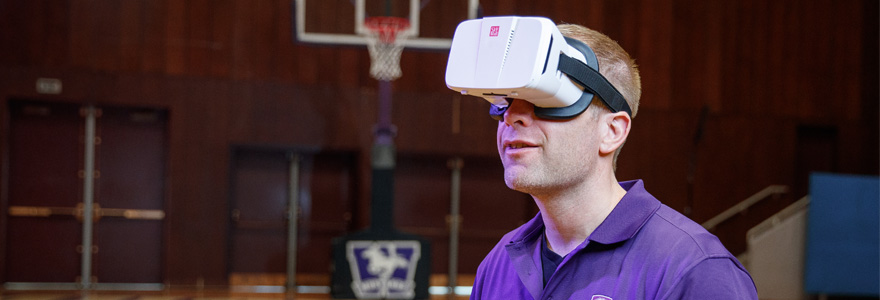
Professor Paul Frewen demonstrates the VR technology at Western Alumni Hall. (Photo by Steven Anderson)
Story by Prabhjot Sohal
With fans gearing up for NCAA March Madness basketball, Western researchers say you may soon be able to grab a VR headset and cheer on your team from wherever you are, experiencing the excitement as if you were courtside.
The findings of the new project show that with a simple 360-degree camera set-up at centre court, viewers preferred watching livestreams of sports via virtual reality technology (3D) over regular 2D screens because it ‘teleported’ viewers to the live sporting action and made them feel as if they were experiencing the game in real-time.
“Using VR, your eyes become the eyes of the camera. You can watch sports from the comfort of your own home, but feel as if you’re sitting in the stands with thousands of other fans,” said Paul Frewen, professor of psychology and psychiatry in the Faculty of Social Science and the Schulich School of Medicine & Dentistry.
The project – Being where, when, and with whom it happens: Presence in VR and live streaming of collegiate sports at Western – was led by Frewen and Andrew Vincent, an undergraduate student in the department of psychology. The project sought to assess the experience of spatial, temporal and interpersonal presence while viewing Western Mustangs volleyball and basketball games in virtual reality (3D) versus standard tablet format. To do this, the Mustangs men’s and women’s volleyball and basketball games were live-streamed to YouTube from the centre court at Alumni Hall using a 360-degree camera, which allowed viewers to experience the game from all angles.
“We were interested in knowing how close the VR experience feels to actually being at the game – whether or not VR could make viewers feel they were watching it live with spectators present at the sporting venue,” said Frewen, who is also testing real-time, 360-degree virtual teaching as part of Western-funded projects that are examining the use of the university’s Bell-Western 5G network.
“VR experiences in the context of gaming have been studied, but their application in sports and live streaming of sports hasn’t received much attention,” he said.
For this project, participants were asked to view the games in both virtual reality (using a VR headset) and on a tablet computer. They were asked to self-assess how spatially, temporally and interpersonally present they felt while watching the games in each modality.
Overall, participants reported feeling more present in the game when using virtual reality technology. About half of the participants preferred watching the games in VR, while 30 per cent preferred the tablet and 22 per cent reported no preference.
“We found participants using VR headsets to view the live stream felt more spatially and temporally present as if they were in the stadium watching the game live – front row and centre. Fascinatingly, the more a person felt spatially present during VR viewing, the more they preferred watching the games in VR,” said Frewen. “Participants using VR also felt more connected to the other people who were watching the game with them, even though they were physically separated.”
So, what could this mean for the future of sports viewing? Vincent says a lot.
“Creating the VR experience wasn’t cumbersome or expensive. We used very simple technology for this – a 360-degree camera and regular VR headsets. Knowing many viewers prefer the VR experience, it could be a great idea for sports to provide special VR viewing areas or provide live streams that people can view with mobile VR headsets using their mobile devices,” said Vincent, who is also studying VR applications in an educational setting.

